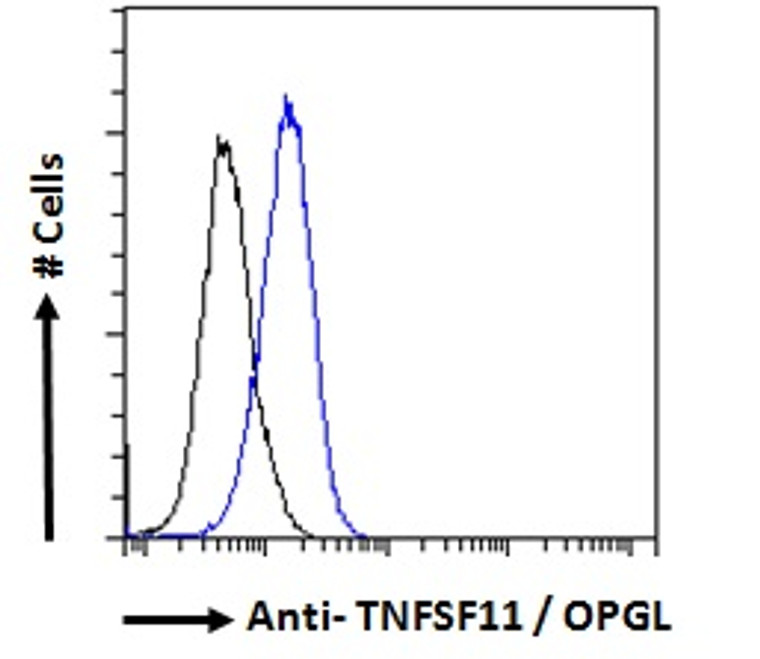| Host: |
Goat |
| Applications: |
Pep-ELISA/IF/FC |
| Reactivity: |
Human |
| Note: |
STRICTLY FOR FURTHER SCIENTIFIC RESEARCH USE ONLY (RUO). MUST NOT TO BE USED IN DIAGNOSTIC OR THERAPEUTIC APPLICATIONS. |
| Short Description: |
Goat polyclonal antibody anti-TNFSF11/OPGL (Internal) is suitable for use in ELISA, Immunofluorescence and Flow Cytometry research applications. |
| Clonality: |
Polyclonal |
| Conjugation: |
Unconjugated |
| Isotype: |
IgG |
| Formulation: |
0.5 mg/ml in Tris saline, 0.02% sodium azide, pH7.3 with 0.5% bovine serum albumin. NA |
| Purification: |
Purified from goat serum by ammonium sulphate precipitation followed by antigen affinity chromatography using the immunizing peptide. |
| Concentration: |
0.5 mg/mL |
| Dilution Range: |
IF-Strong expression of the protein seen in the membranes of MCF7 and NIH3T3 cells. 10µg/mlELISA-antibody detection limit dilution 1:16000. |
| Storage Instruction: |
Store at-20°C on receipt and minimise freeze-thaw cycles. |
| Gene Symbol: |
TNFSF11 |
| Gene ID: |
8600 |
| Uniprot ID: |
TNF11_HUMAN |
| Immunogen Region: |
Internal |
| Accession Number: |
NP_003692.1; NP_143026.1 |
| Specificity: |
This antibody is expected to recognise both reported isoforms (NP_003692.1 and NP_143026.1). |
| Immunogen Sequence: |
DLAKRSKLEAQP |
| Post Translational Modifications | The soluble form of isoform 1 derives from the membrane form by proteolytic processing. The cleavage may be catalyzed by ADAM17. |
| Function | Cytokine that binds to TNFRSF11B/OPG and to TNFRSF11A/RANK. Osteoclast differentiation and activation factor. Augments the ability of dendritic cells to stimulate naive T-cell proliferation. May be an important regulator of interactions between T-cells and dendritic cells and may play a role in the regulation of the T-cell-dependent immune response. May also play an important role in enhanced bone-resorption in humoral hypercalcemia of malignancy. Induces osteoclastogenesis by activating multiple signaling pathways in osteoclast precursor cells, chief among which is induction of long lasting oscillations in the intracellular concentration of Ca (2+) resulting in the activation of NFATC1, which translocates to the nucleus and induces osteoclast-specific gene transcription to allow differentiation of osteoclasts. During osteoclast differentiation, in a TMEM64 and ATP2A2-dependent manner induces activation of CREB1 and mitochondrial ROS generation necessary for proper osteoclast generation. |
| Protein Name | Tumor Necrosis Factor Ligand Superfamily Member 11Osteoclast Differentiation FactorOdfOsteoprotegerin LigandOpglReceptor Activator Of Nuclear Factor Kappa-B LigandRanklTnf-Related Activation-Induced CytokineTranceCd Antigen Cd254 Cleaved Into - Tumor Necrosis Factor Ligand Superfamily Member 11 - Membrane Form - Tumor Necrosis Factor Ligand Superfamily Member 11 - Soluble Form |
| Database Links | Reactome: R-HSA-5668541Reactome: R-HSA-5669034Reactome: R-HSA-5676594 |
| Cellular Localisation | Isoform 1: Cell MembraneSingle-Pass Type Ii Membrane ProteinIsoform 3: Cell MembraneIsoform 2: CytoplasmTumor Necrosis Factor Ligand Superfamily Member 11Soluble Form: Secreted |
| Alternative Antibody Names | Anti-Tumor Necrosis Factor Ligand Superfamily Member 11 antibodyAnti-Osteoclast Differentiation Factor antibodyAnti-Odf antibodyAnti-Osteoprotegerin Ligand antibodyAnti-Opgl antibodyAnti-Receptor Activator Of Nuclear Factor Kappa-B Ligand antibodyAnti-Rankl antibodyAnti-Tnf-Related Activation-Induced Cytokine antibodyAnti-Trance antibodyAnti-Cd Antigen Cd254 Cleaved Into - Tumor Necrosis Factor Ligand Superfamily Member 11 - Membrane Form - Tumor Necrosis Factor Ligand Superfamily Member 11 - Soluble Form antibodyAnti-TNFSF11 antibodyAnti-OPGL antibodyAnti-RANKL antibodyAnti-TRANCE antibody |
Information sourced from Uniprot.org
12 months for antibodies. 6 months for ELISA Kits. Please see website T&Cs for further guidance









